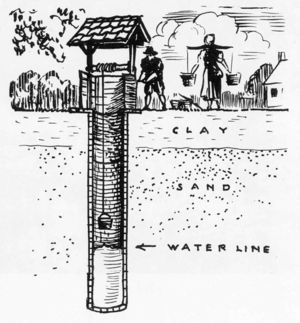Wells
Wells are mostly used for water supplies where mains water is not installed. They may also be used at metered properties to reduce water bills.
Construction
Historic
Historic well construction was a risky process that involved a person going down the well shaft as they dug. It was typically undertaken by individuals with more interest in getting drunk than in their own safety. In some locations a well could require well over a hundred feet of descent.
Old industrial wells were in some cases massive affairs. The largest used multiple large well shafts 100s of feet long, added a maze of deep horizontal subterranean tunnels several miles long, then from the tunnels many vertical boreholes. These would be used for industries requiring high water output, and water supply companies. Some of these large wells are still in service.
Modern
Modern wells are more often just boreholes, usually 4" to 6" wide, drilled by machine. Skill is needed to bore such a well, it is not a case of hiring a machine and expecting it to do the job.
Maintenance
Reinstating a discovered old well sometimes requires work to resolve some problem. In the event of problems, Google is your friend.
Water Safety
There are various potential problems with well water, including:
- pesticide residue
- foul water contamination
- bacterial contamination
- excess levels of one mineral, which can cause deficiencies in other minerals in humans and animals
Well water should be tested before use as potable water. The need for corrective action is common.
Legalities
Water harvesting from ground & river are governed by the Environment Agency.
It has been stated that if the water is for one's own use & the borehole does not affect a water source some one else is licensed to extract from, then upto 20 tonnes of water a day can be extracted without need for a license. This needs confirmation.
The use of well water does not exempt the owner from the disposal charge for that well water. Disposal makes up in the region of half the price of the typical water bill. To legally escape disposal charges one must ensure that waste water does not enter the water co's drainage system either directly or indirectly. Thus for example discharge onto a road would not exempt one from disposal charges. A soakaway that does not overflow would meet this requirement.
Cisterns
Underground cisterns are sometimes mistaken for wells. These are large buried containers, usually built in situ of brick, into which rainwater discharges. These were a supply of water for some houses in centuries past, and typically capture roof water. The water is inevitably contaminated by bird crap and other roof borne debris.
